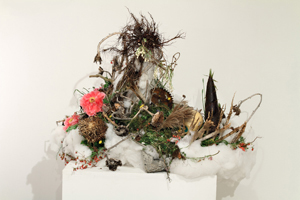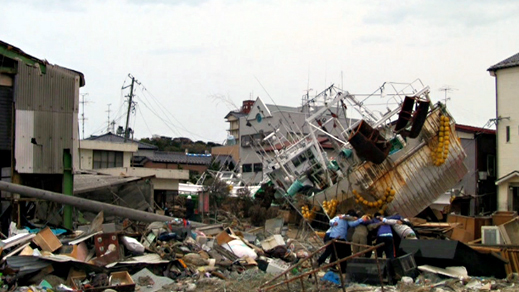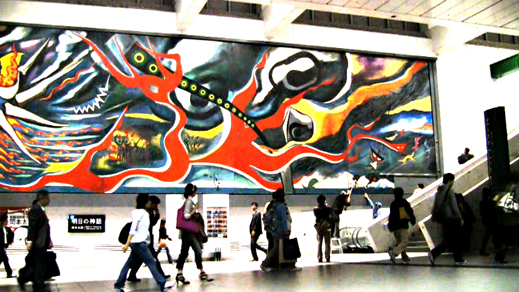 |
| Installation view of "Real Times" at the Mujin-to Production gallery; photo by Kei Miyajima, © 2011 Chim Pom. |
The Japanese art scene today is full of ambitious young Dadaists flaunting their irreverent takes on art or the world at large. But no one does irreverence quite so hilariously as the six-person collective known as Chim Pom. Normally the name appears with an upward-thrusting arrow in the middle; "Chim Pom" derives from a slang term for penis. Consisting of Ellie (the only female member), Ryuta Ushiro, Yasutaka Hayashi, Masataka Okada, Toshinori Mizuno and Motomu Inaoka, the group formed in Tokyo in 2005 and first achieved notoriety with its "Super Rat" installation the following year.
 |
"Radiation-exposed Flower Harmony,"
ikebana collaboration with Jun'ichi Kakizaki (2011);
photo by Kei Miyajima, © 2011 Chim Pom. |
"Super Rat" involved the capture and stuffing of several of the large rats that browse through garbage in the alleys of Shibuya, Tokyo's teeming youth-culture mecca. Chim Pom arranged the animals in poses reminiscent of the Pokemon anime character Pikachu. The artists later explained that they thought the rats (and Pikachu) looked remarkably like the teenage girls who frequent the district.
Subsequent productions continued the theme of tweaking urban taboos -- notably "Black of Death" (2007) in which the artists drove a large stuffed crow through the streets of Tokyo on a motorcycle, attracting hordes of circling birds by blaring crow calls through a loudspeaker.
Gradually, however, the group seems to have edged its way -- winking furiously all the time, mind you -- into areas of social commentary that betray concerns beyond standard-issue tweakery. For "I'm Bokan" (2007) Chim Pom flew to Cambodia, where they dropped household appliances and other personal possessions onto the minefields, and filmed the detonations from the air.
But it was not until 2009 that the group achieved nationwide visibility when they skywrote the word Pika (onomatopoeia for the flash of the atomic bomb) above the city of Hiroshima. Public outrage was instant, particularly from aging A-bomb survivors who felt their sensibilities were being mocked. For the first time in its career, Chim Pom was compelled to call a press conference to explain itself and apologize for the hurt it had caused. Though the group's explanation sounded less than convincing -- something about calling attention to the fading of the bomb from Japan's collective memory -- it redeemed itself in impressive fashion by following up with a nationwide tour in tandem with one of Hiroshima's leading spokesmen for the survivors.
My first encounter with Chim Pom was at their Tokyo event on this tour. When an audience member asked Mr. Tsuboi, the survivors' representative, what he thought of Chim Pom when he first learned about the skywritten "Pika," he snapped, "I thought they were idiots!" Then he grinned. It was obvious that somehow, the survivors and Chim Pom had achieved a sort of detente, if not complete understanding.
I was not really surprised, then, when I heard that in the wake of the twin disasters of tsunami and nuclear meltdown in Fukushima, Chim Pom had taken its guerilla art tactics right into the no-go zone, within shouting distance of the stricken -- and still radiation-spewing -- reactors. "Real Times," the group's latest installation, documents this confrontation with post-3/11 reality in compelling fashion.
 |
| Image from the Chim Pom video "100 KIAI" (2011); © 2011 Chim Pom. |
When I entered the gallery, the video (one of several) that first caught my attention showed Chim Pom's members in a huddle amid the tsunami-smashed rubble of Soma, a coastal city on the edge of the nuclear no-go zone. With an upended fishing boat in the background, they embark on an endless loop of enthusiastic cheers, mostly absurd, yelling everything from "Long live life!" to "Long live nuclear disasters!" At first I thought this was a cynical jab at fair-weather volunteers who flock to the disaster area only to spend their time congratulating themselves on volunteering instead of doing any actual work. It turns out, however, that the young people in the huddle included residents of Soma, and that Chim Pom spent several days helping them clean up their devastated neighborhoods.
No guerilla art is worth its salt without an actual run-in with the law, and Chim Pom did not disappoint in this regard. Another video chronicles an "addition" they surreptitiously appended to "Myth of Tomorrow," the famed mural of atomic holocaust by Taro Okamoto that covers a wall in busy Shibuya station. Chim Pom's contribution was a panel, built to fit seamlessly to Okamoto's mural without damaging it, of the smoking remains of the exploded reactors -- an update to the original, if you will. The "addition" remained in plain view, passed (and generally ignored) by thousands of commuters for an entire day before someone took it down, and it took the police another two weeks to trace it to Chim Pom. So far there have been no arrests.
 |
| Chim Pom members adding their contribution to Taro Okamoto's "Myth of Tomorrow" mural in full view of commuters at Shibuya station; © 2011 Chim Pom. |
A third video follows two Chim Pom members in radiation suits as they walk to a tourist overlook (the road now a jumble of cracked asphalt) only a few hundred yards from the Fukushima Daiichi nuclear plant, which you can see steaming in the background. There they take out a white banner, spray-paint it with the universal symbol for radiation -- uncannily like Japan's Rising Sun -- and hoist it aloft. One wonders how many microsieverts they absorbed in the process.
The videos are fascinating, but they are not the most unnerving elements of "Real Times." Those would be an ikebana arrangement of radioactive flowers and plants picked near the reactors -- a Geiger counter next to it read 0.21 microsieverts when I was there -- and a wall of still photos of pets (starving) and cattle (dead) abandoned in the no-go zone.
Mujin-to Production, an umbrella group that manages Chim Pom and several other artists who are kindred spirits, hosted "Real Times" for a week in late May at its new gallery in Fukagawa on the east side of the Sumida River. From there the installation moved on to Osaka for another week in late June. It would be a pity if that were the end of it; I hope Mujin-to and Chim Pom see fit to take the show on the road, not only in Japan but overseas. "Real Times" represents a new level of sophistication in the collective's art. After some years of trial and error they have attained an admirable balance on the razor-thin line between satire and nonsense -- all the while thumbing their noses at those who would make any such distinction. In "Real Times" Chim Pom wields irreverence like a weapon to shield what is, in fact, a deadly serious message.
 |
Chim Pom members hoist their hand-painted radiation flag with the Fukushima Daiichi nuclear plant in the background; © 2011 Chim Pom.
All images courtesy of Mujin-to Production, Tokyo |